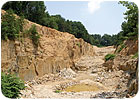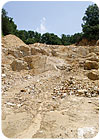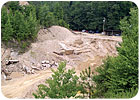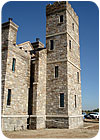
Joe Vinci’s experience in the quarrying business dates back to his childhood, when he used to help his father at his stone-producing company in Marriottsville, MD. He remembers making trips to the Butler Stone Quarry in nearby Butler, MD, and being impressed with the thriving business back in the 1960s and 1970s. Vinci never abandoned his dream of owning the historic quarry, and in 2005, he made it a reality. After dedicating two years to cleaning up the site, Vinci and his team at Vinci Stone Products are eager to have the quarry once again running at a successful production capacity.
“This quarry is something that I always wanted,” said Vinci. “In 1962, when I was 12 years old, I started helping my dad. I answered phones, and I drove a pick-up truck back and forth from the shop to the Butler Quarry. I had always told my dad that this place was incredible. It was a buzz of activity in the ‘60s and ‘70s. I always felt that the stone was a gorgeous material.”
Stone World had the opportunity to recently visit with Vinci at the Butler Stone Quarry location, and he explained its storied past. According to Vinci, the previous owners acquired the business in 1990, and he purchased the site just before the owner passed away. “I bought the whole operation on June 7, 2005,” he said.
Since purchasing the Butler Stone Quarry, Vinci has worked very closely with the State of Maryland as well as the Federal Government during the cleanup process, to ensure that everything was being done safely and correctly. While he was involved with rebuilding the Butler Stone Quarry, he also continued to run Vinci Stone Products in Marriottsville, which he took over in 1974. In addition to the Butler site, the company also owns two quarries in Marriottsville.

The company has produced between 6,000 to 8,000 tons of Butler building stone per year since 2005.
Producing Butler stone
“We operated since the day that we took over,” said Vinci, when speaking about the 25-acre Butler Stone Quarry. “We brought a crew over from the Marriottsville location. The previous owners weren’t getting much stone out. We wanted to get production up, and we did. We have a feeling that what we produced in two years is more than the previous owner did in 10 years.”According to Vinci, the quarry has produced between 6,000 to 8,000 tons of building stone per year since 2005. He explained that the material is used on almost every university campus in Maryland.
In addition to building material, Butler stone is also ideal for landscape projects, according to Vinci. “The silver, grays and browns [in the stone] lend well to landscaping,” he said.
Vinci went on to explain that Butler stone is geologically classified as a gneiss. “It’s in the granite family,” he said. “The state of Maryland has told us that they have records [of the quarry] dating back to the 1800s.”
Last year, Vinci Stone Products had its biggest crew ever in place to quarry at all three locations. In total, there were 65 workers. “This year we have about 40,” he said. “Last year we had three different crews. This year, since the building market slowed down a bit, we decided that we would have one crew and float them out where we need them.”
The company tries to keep the quarries open year-round. “We keep a core crew from December to March,” he said, explaining that many of his workers return to their homes in Mexico during the winter months.
At the Butler quarry, the stone sits within the earth at a 90-degree vertical angle, said Vinci. “It’s unusual,” he said about the straight up-and-down inclination of the stone. “We suspect that at some point we will find where it is lifted, and then it will go back to flat.”
A typical quarry bench is between 12 to 18 feet thick, and they are shaped in the form of massive stone steps. Quarry workers first strip the area, then drill and blast. “We blast about once a month at each location,” said Vinci, explaining that they use water gels.
After the stone is blasted, it is taken to a “surge” area where workers use hammers to get the stone as thin as possible so it can then go through the hydraulic splitters. “When we finish with it, it is pretty much ready for the mason to lay,” said Vinci. There is not much trim work needed.”
The company recently purchased a new splitter from Cee-Jay Tool Co., Inc. of Loveland, CO. Additionally, the company uses splitting machinery from Park Industries, and Vinci also designed his own splitter that is used at the quarry site. Other equipment includes a Cougar bridge saw from Park Industries that was left by the previous owners.
When the quarrying process is completed, screens are used to reclaim useable pieces of stone that had been left within the dirt, and the dirt itself is also sold.
Currently, to meet the demands for thin stone veneer production, Vinci Stone Products is shipping some material to Rolling Rock Building Stone Inc. in Boyertown, PA, and Meshoppen Stone Inc. of Meshoppen, PA, for processing as needed. But, plans are underway to purchase a thin stone veneer production unit from Park Industries.

The original Vinci quarry, which was purchased by Vinci’s father in the 1940s, is located just down the road from the company’s current headquarters in Marriottsville, MD. The 25-acre site is predominantly flagstone, and produces between 2,000 to 4,000 tons of material annually.
The Vinci Quarry
The original Vinci Quarry, which was purchased by Vinci’s father in the 1940s, is located just down the road from the company’s current headquarters in Marriottsville, MD. Material from the 25-acre site is predominantly used for flagstone, and the quarry produces between 2,000 to 4,000 tons of material annually.“The nice thing about flagstone is that it is a higher-priced product,” said Vinci. “The stone here is a mica schist.” The material is whitish brown in color, and its surface remains cool in hot climates -- making it ideal for the Florida market, according to Vinci.
The quarry dates back to between 1914 and 1916. Unlike the vertical position of the stone at the Butler site, the flagstone here sits on an angle. The same quarrying methods are used, though.
To determine which areas of the site are best suited from quarrying, workers randomly drill different areas of the land. “They measure how fast the drill descends,” explained Vinci. “If we see that it drops 10 feet in 10 seconds, then the material is not good. We can also tell by the sound that the drill makes. It gives us a pretty good interpretation of what we have.”
“I would say that there is easily 20 to 50 years left to quarry,” said Vinci, when speaking about the Vinci Stone Quarry.

Many residences in the area feature stone quarried by Vinci Stone Products. Photo courtesy of Vinci Stone Products
The Piccirilli Quarry
The other flagstone quarry owned by Vinci Stone Products is the Piccirilli site, which is located directly across the street from the company’s headquarters. This material is a Wissahickon schist, which is a darker-colored stone called “Mocha.”This quarry also spans about 25 acres, and its production is between 6,000 to 8,000 tons per year.
Vinci explained that this site was also not in the best condition when he purchased it, requiring the company to invest a lot in the cleanup of that quarry as well.
As with the other quarries, the material left over from quarrying is also screened at the Piccirilli quarry. The dirt from this site though meets the standards to qualify as baseball diamond dirt, because it does not have a lot of organic material in it, explained Vinci. Last year, Vinci Stone Products sold about 20,000 tons of the dirt to local municipalities for baseball fields.
At this time, the flagstone from this site is taken over to the Vinci Stone Quarry for cutting, but eventually, Vinci hopes to have a splitter on location.

In the future, Joe Vinci, president of Vinci Stone Products, plans to hire a marketing manager to continue to promote the company’s material to architects and designers. This will hopefully lead to many more prestigious projects such as high-end residences as well as university and governmental buildings.
Future plans
In 2008, Vinci Stone Products will celebrate its 50th anniversary. By this time, Vinci hopes to have the headquarters relocated to the Butler Stone Quarry location. “We are looking forward to 2008,” he said. “We’ve come a long way, but we have a long way to go. We are up for the challenge though.”Additional plans include hiring a marketing manager who can help introduce the company’s stone products to the architectural and design community. “Architects and designers don’t want to be pushed,” said Vinci. “We want someone to give them brochures and samples, and who can be there to answer their questions.”
Recent projects that used Butler stone are the Donnelly Science Center at Loyola University; buildings on the campus of Morgan State University; and the new International Masonry Institute in Laurel, MD. Additionally, the company is currently extracting and processing about 4,000 tons of Butler stone to be used for the School of Nursing building at Villanova University in Villanova, PA. The company is also a contender for a government building that is being constructed in Norton, VA.
